Hyman Bloom’s Studio
Hyman Bloom: Paintings and Drawings (1940–2005), currently at White Box (the cutting edge international art space on Broome Street), is a rare opportunity to observe the creative process of one of the most important practitioners of 20th century Jewish Art in America. It is as if the artist invited you into the most private recesses of his studio (which in reality he never would permit), put his arm around you and explained, “this is exactly how an artist makes paintings about being a modern Jew.” Considering the subject of the paintings and the nature of the venue, this is a shocking and gutsy show.
Bloom, who passed away in 2009 at the age of 96, was a highly respected and yet tragically under-valued star of the mid-century avant-garde. Born is Latvia in 1913, his traditional cheder education quickly fell by the wayside upon immigration to the United States and settlement in Boston in 1920. Art school at the Boston Museum of Fine Arts and the local West End settlement house eventually led to working on the Federal Art Project (WPA) where he blossomed artistically. On the occasion of his retrospective at the National Academy of Design in December, 2002, I related:
… Dorothy Miller, curator at the Museum of Modern Art in New York, visited his studio [in Boston] in 1941 and included him in “Americans 1942” at the Modern. His paintings of that era include “The Bride,” “Rabbi,” “The Synagogue” as well as paintings of “Female Corpse” and “Corpse of Man.” “The Synagogue,”[depicting the Kol Nidrei service] purchased by the Modern in 1943, was part of the opening exhibition of the Jewish Museum in 1947.
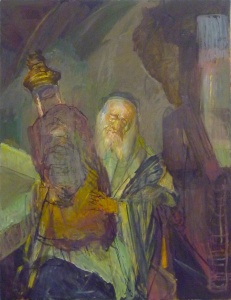
In 1950 he is one of seven artists, including Arshile Gorky, John Marin, Jackson Pollack and Willem de Kooning to represent the United States at the Venice Biennale. By all accounts, Bloom had become an established member of the American modern art scene.
In 1954 Jackson Pollack and Willem de Kooning considered Bloom “the first Abstract Expressionist artist in America.” In 1954 he had a major retrospective at the Whitney Museum of American Art. Even though he was considered an insider, he willfully remained on the periphery of the Abstract Expressionist movement in New York and slowly drifted out of public notice and the New York art world.
In the subsequent years he sequestered himself away from the Boston and New York art scenes and pursued a metaphysical journey creating paintings of fantastic landscapes, séances, seascapes, still lifes, trees and hallucinatory fish. In the current exhibition none of these subjects are shown (other than one recent Still Life from 2002 and one Christmas Tree from 1983 just to assure visitors of Bloom’s other work). Rather, the extraordinary 18 paintings of “rabbis” here all date from the last 25 years of his life and represent the underlying struggle with meaning and spirituality that defined his entire artistic life.
No artist’s lifetime of work can or should be summed in one sweeping statement. With that acknowledged, Bloom’s paintings of rabbis, first created in the 1940s and continued to be made until the very end of his life, represent a major personal and artistic struggle, conscious or not, to come to terms with being an assimilated Jew in modern America.
Menachem Wecker trenchantly observed upon reviewing the rabbi paintings in 2009… “The rabbis in Hyman Bloom’s paintings look like rabbis, dress like rabbis, and come with all the usual rabbinic accessories: beards, hats, kippas and Torah scrolls. But don’t let that fool you… they aren’t real.” Rather they are “imaginary constructs…” Indeed they are barely concealed portraits of the archetypical Jew lurking inside the very contemporary Hyman Bloom.
Bloom’s paintings easily transcend the trope of solipsistic self-portraits. Rather he decided to play out his secret obsession with the lush tools of painterly expressionism that came so naturally to him, utilizing a veritable encyclopedia of art historical references, returning to these paintings year in year out over the decades of his old age. The works exhibited here were almost all gleaned directly from paintings left in his studio after his death, expertly chosen and hung by the curator Jan Frank with the full collaboration of Juan Puntes (Founder and Artistic Director) and Tony Guerrero (Executive Director) of White Box.
Each of these eighteen paintings is a large work ranging from 48” x 40” to 72” x 55”. In every painting a robed figure holds a Torah scroll, many also holding a large book in his free hand. Each man is bearded, with a skullcap or clerical head covering; over half wear one type of streimel or another. Collected here is a random catalogue of religious Jewish men. The notion that they are “rabbis” is of course simply a cultural shorthand reflecting that the images represent Jewish individuals with a close connection to the Torah; fervently holding, clasping or embracing this holy object, the font of all Jewish knowledge and wisdom. In reality and, I would assert, in Bloom’s mind, these were simply Jewish men with the ultimate symbol of their faith and people. It is clear he couldn’t get them out of his mind.
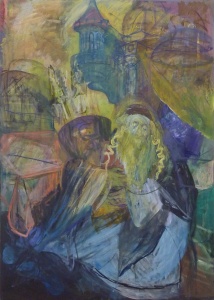
Viewing them clockwise and starting on the left wall allows us to sample Bloom’s painterly and Jewish concerns and imagine an underlying narrative. Number 1 (please forgive the arbitrary numbering but they are all identified as Jew with Torah or Rabbi with Torah) introduces a spectral dark-haired figure, the daub of orange and white animates his eye just as a translucent diagonal connects the substance of the Torah he holds with a supernal realm in the upper left. Looking up from the book he holds, this Jew is secure in all aspects of his faith.
Number 2 is older and more contemplative. He hovers between standing and sitting, holding the crowned scroll in a calm tranquil environment, only the agitated charcoal lines drawn later delineate his features and aged hands. The Torah is his rightful possession, but slightly distant, and yet in perfect Rembrandtian balance with his august presence.
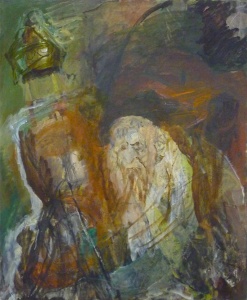
The next set of paintings are hung four-square, summoning “The Four Ages of Rabbis.” The young blond Jew with a vibrant rust-colored streimel matched by the crimson Torah cover is surrounded by bold black and white talis. His hands are barely sketched in as he strides towards the viewer, bold and confident. Next a mature black haired rabbi, eyes wide open, seems to embrace both Torah and sacred book equally. The agitated brushstrokes create a lively tension underlying his calm demeanor. The lower left painting of the set depicts a pious old fool sitting with his Torah, green hued and white haired in a blissful revere. Finally (Number 6) an old gnome tightly clasps his Torah outlined by an electric white charge. He is the “grumpy” of the series, a bitter figure casting a skeptical eye off to the side; mostly in shades of white overshadowed by threatening Prussian blue clouds lit by an orange glow. The form is created simultaneously from the outside in and from the animated surrounding negative space, an unmistakable echo of De Kooning (The art historical references Bloom introduces never define his images; rather they only contextualize his meaning, casting the Jewish subjects in a foreign, unsettling and revealing light of the references themselves).
Next we see a lone lyrical fantasy in pastel pinks, yellows, blues and violets that place our rabbinic figure before a Disneyland apparition of castle-like structures. The golden sky bleeds down into the glowing rimonim which in turn illuminate the sitter’s ample white beard and fantastic swirls of calligraphic peyos. He concentrates his deliberate strides, cascading through the picture plane, fleeing the fantasy world behind him.
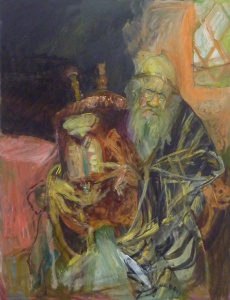
One might imagine contemplation would be the predominant rabbinic mode, but these “rabbi” paintings are immersed in a psychic combat, restless and troubled. The contemplation of Number 9 is an exception, emphasized by the naturalism of the light shining through the lattice window on the right, surrounded by a peach-colored wall. The light passes behind the sitter, finally landing on the glowing pink end table on the left. The figure is sandwiched between these two evocative colors, deep in thought, absentmindedly stroking the deep red velvet Torah cover in the midst of painterly line, texture color and gesture.
These are never “Rebbi Paintings” in any sense of the term. Rather they explore the spirit of thinking Jewish men wrestling with the foundations of their (and Bloom’s) ancestral faith.
The end wall is occupied by the two largest works, both of which open up the pictorial space; especially the painting on the right, Number 12. Here the rabbi is in his grandest environment, a vaulted cavernous space reminiscent of the mystical synagogues of Safed, massive columns supporting blue painted vaults. Here our rabbi seems to float slightly over the earth-colored floor, a lone human presence grasping the Torah as his only anchor.
This show is deeply instructive about the process of making significant art utilizing modernist means to plumb the complexities of the religious spirit. Number 15 is an image in formation, barely visible as it emerges from thin swaths of color and agitated lines, gestural white chalk drawing and our visual memory from the other rabbi motifs. These works are never illustrative or descriptive. Rather the process hews at the subtle problems of faith and corporal temptation with the raw elements of paint, color, line, texture and image. Meaning emerges from the making.
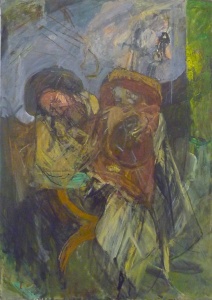
While each painting summons its unique universe, the last painting, Number 18, represents the dramatic conclusion to the series (which was, of course, created by the curators who hung the show). The luminous painting glimmers with an electric green, defining and creating space. Significantly the rabbi turns away from his Torah that rests in his left arm (the “incorrect” arm to hold the Torah). His eyes are closed and in anguish. He twists back in his chair, a figure in revulsion, pinned down by his burden. The Torah seems to present him with a conundrum unlike any other painting here. In this painting the holy object is his adversary that he cannot shed. This grand and tragic painting is the unsettled finale of Bloom’s lifelong struggle with the living content of his Jewish heritage.
For Bloom and his generation the only way to become a contemporary artist was to quickly shed the Yiddishkeit he was born into. And yet a vibrant piece of the Torah itself remained with him for over nine decades, gnawing at his creative fiber and demanding to be recognized as the ancient core of his being. These extraordinary paintings are testament to Hyman Bloom’s Jewish soul.
Hyman Bloom’s Studio
Paintings and Drawings (1940-2005)
White Box
329 Broome Street, New York, NY 10002
212 714 2347 / www.whiteboxny.org
Monday – Friday 11am – 6pm
Until September 22, 2013